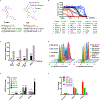Imidazole Ketone Erastin Induces Ferroptosis and Slows Tumor Growth in a Mouse Lymphoma Model
- PMID: 30799221
- PMCID: PMC6525071
- DOI: 10.1016/j.chembiol.2019.01.008
Imidazole Ketone Erastin Induces Ferroptosis and Slows Tumor Growth in a Mouse Lymphoma Model
Abstract
Ferroptosis is a form of regulated cell death that can be induced by inhibition of the cystine-glutamate antiporter, system xc-. Among the existing system xc- inhibitors, imidazole ketone erastin (IKE) is a potent, metabolically stable inhibitor of system xc- and inducer of ferroptosis potentially suitable for in vivo applications. We investigated the pharmacokinetic and pharmacodynamic features of IKE in a diffuse large B cell lymphoma (DLBCL) xenograft model and demonstrated that IKE exerted an antitumor effect by inhibiting system xc-, leading to glutathione depletion, lipid peroxidation, and the induction of ferroptosis biomarkers both in vitro and in vivo. Using untargeted lipidomics and qPCR, we identified distinct features of lipid metabolism in IKE-induced ferroptosis. In addition, biodegradable polyethylene glycol-poly(lactic-co-glycolic acid) nanoparticles were employed to aid in IKE delivery and exhibited reduced toxicity compared with free IKE in a DLBCL xenograft model.
Keywords: DLBCL; ROS; cancer; cell death; cysteine; cystine; erastin; ferroptosis; glutathione; lipidomics; lymphoma; nanoparticle; peroxidation; system x(c)(–).
Copyright © 2019 Elsevier Ltd. All rights reserved.
Conflict of interest statement
DECLARATION OF INTERESTS
BRS holds equity in and consults with Inzen Therapeutics. BRS is an inventor on a patent related to this work. BRS and YZ are inventors on a patent application related to this work.
Figures





Comment in
-
Aiming at Cancer In Vivo: Ferroptosis-Inducer Delivered by Nanoparticles.Cell Chem Biol. 2019 May 16;26(5):621-622. doi: 10.1016/j.chembiol.2019.05.002. Cell Chem Biol. 2019. PMID: 31100261 Free PMC article.
References
-
- CHAKRABORTI S 2003. Phospholipase A2 isoforms: a perspective. Cellular signalling, 15, 637–665. - PubMed
-
- CHAPUY B, STEWART C, DUNFORD AJ, KIM J, KAMBUROV A, REDD RA, LAWRENCE MS, ROEMER MGM, LI AJ, ZIEPERT M, STAIGER AM, WALA JA, DUCAR MD, LESHCHINER I, RHEINBAY E, TAYLOR-WEINER A, COUGHLIN CA, HESS JM, PEDAMALLU CS, LIVITZ D, ROSEBROCK D, ROSENBERG M, TRACY AA, HORN H, VAN HUMMELEN P, FELDMAN AL, LINK BK, NOVAK AJ, CERHAN JR, HABERMANN TM, SIEBERT R, ROSENWALD A, THORNER AR, MEYERSON ML, GOLUB TR, BEROUKHIM R, WULF GG, OTT G, RODIG SJ, MONTI S, NEUBERG DS, LOEFFLER M, PFREUNDSCHUH M, TRUMPER L, GETZ G & SHIPP MA 2018. Molecular subtypes of diffuse large B cell lymphoma are associated with distinct pathogenic mechanisms and outcomes. Nat Med, 24, 679–690. - PMC - PubMed
-
- CHEN L, LI X, LIU L, YU B, XUE Y & LIU Y 2015. Erastin sensitizes glioblastoma cells to temozolomide by restraining xCT and cystathionine-γ-lyase function. Oncology reports, 33, 1465–1474. - PubMed
Publication types
MeSH terms
Substances
Grants and funding
LinkOut - more resources
Full Text Sources
Other Literature Sources
Molecular Biology Databases

